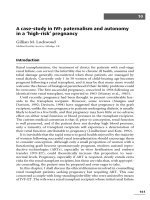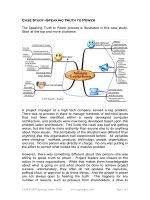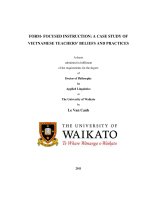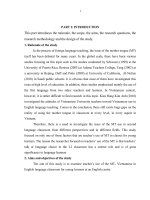Case Study: guangzhou, chinas bus rapid transit system
Bạn đang xem bản rút gọn của tài liệu. Xem và tải ngay bản đầy đủ của tài liệu tại đây (214.77 KB, 3 trang )
Low Carbon Green Growth Roadmap for Asia and the Pacific
CASE STUDY
High-quality investment matters
Guangzhou, China’s bus rapid transit system
Key points
•
Bus rapid transit can be a cost-effective mode of public transport for cities experiencing congestion,
given the high carrying capacity, compared with conventional buses, and the smaller upfront investment
needed, compared with the rail-based transport.
•
Although the government’s ability to overcome public resistance was critical to jump-start change in
Guangzhou, investment in a high-quality BRT system enabled the operation of financially viable services
by attracting passengers with the increased speed, convenience and connectivity.
There was a problem…
Guangzhou is one of the fastest-growing cities in the world. Rapid motorization had taken place in the city for
three decades, leading to congestion and an unhealthy environment.
What was done?
In 2010, Guangzhou began a scheme to improve both public transport and the local environment and reduce
the level of greenhouse gas emissions from the transport sector. A key part of this package was the development
of a bus rapid transit (BRT) network.
The city’s BRT system was launched in February 2010. Working with the Guangzhou Municipal Engineering Design
and Research Institute, the international Institute for Transportation and Development Policy (ITDP) led the design
and planning of the project.1 The ITDP works with cities worldwide to bring about sustainable transport solutions
that cut greenhouse gas emissions, reduce poverty and improve the quality of urban life.
The infrastructure costs for the following components were US$4.4 million per kilometre and were financed by the
Government:
Quality infrastructure: Sensitively designed infrastructure enables efficient transit between different
modes of transport and easy access to all citizens. The scheme is the first in China to include bicycle
parking at the stations and to include direct tunnels between the metro and BRT stations. Platforms are
at grade with the bus floor, ensuring easy access for mobility-impaired passengers.
Integrated fare system: The BRT and metro fare systems are integrated, which helps ensure a seamless
transition between the two modes.
Synergies with the non-motorized transport (bicycle): To further support the uptake of non-motorized
transport, new bicycle lanes were developed that run parallel to the BRT stations. A bike-sharing scheme
was launched in June 2010, with 1,000 bikes initially.2
Supplementary measures aimed at improving liveability and environmental resilience: As part of the
integrated process, polluted waterways were reclaimed as public space. Tree-lined bicycle lanes were
developed that immensely improved the look and feel of the environment.
•
•
•
•
1
Claudia Gunter, “Guangzhou Opens Asia’s Highest Capacity BRT System” Newsletter of Institute for Transportation and Development
Policy, March 5, 2010. Available from www.itdp.org/index.php/news/detail/guangzhou_opens_highest_capacity_brt/ (accessed 16
November 2011).
2
ibid.
Low Carbon Green Growth Roadmap for Asia and the Pacific : Case Study - Guangzhou, China’s bus rapid transit system
Results
Integrated transport network: The BRT system is well integrated with other public transport modes,
including bike sharing and the metro railway system. The system won the 2011 Sustainable Transport
Award from ITDP.
Increased ridership in public transport: It currently carries 26,900 passengers per direction per hour, with a
daily ridership level of roughly 800,000, supporting a modal shift of 10-15 per cent from private vehicles.
CO2 emission reduction: It is estimated that the scheme has reduced CO2 emissions by approximately
20,000 tonnes a year.3
Time saving: The BRT is estimated to have saved 30 million passenger hours in the city in its first year.
New employment and business opportunity: Guangzhou's BRT opened up a range of employment and
business opportunities for people who were previously restricted by the time and cost required to move
along the Zhongshan Avenue corridor.
•
•
•
•
•
Lesson learned
Investment in the improvement of the quality of the BRT system led to the long-term financial sustainability of the
operation. The high-quality service is expected to cover all operating costs, including bus depreciation and the
installation, operation and maintenance of the fare-collection system.
Success factors
Political leadership: There was significant opposition to the introduction of the scheme from car owners4
and the media. But that was met with strong and unwavering political support for the scheme from the
city mayor. In addition, all provincial and city officials have ridden and endorsed the system.5
Clearly defined responsibilities: The new BRT scheme was to be integrated with improvements to nonmotorized transport and the metro, so there was a need to ensure clearly defined responsibility and
effective communication. The BRT system is regulated by the Public Transport Management Office
(planning) and the BRT Management Co. (control).6 The BRT Management Company oversees the
private companies that are responsible for the operations.7
Appropriate regulatory arrangement for operators: There are seven operating companies in three large
corporate groups that are responsible for managing the operation of the service. This makes some
aspects of regulation more complicated but helps to ensure a good service by providing regulators with
more options. Bus operators are paid per kilometre rather than per passenger.
•
•
•
Considerations for replicating
Countries with a lack of planning and design capacity may resort to the support from an international organization or research institute. Guangzhou turned to the Institute for Transportation and Development Policy to help
ensure the ongoing sustainability of its vision and system. Minor route changes and the gradual introduction of
express routes and larger buses will result in significant operational improvements to ensure increasing passenger
demand continues to be met.8
3
Sabiq Rahim, “Chinese Cities Find Bus Only Lanes an Alternative to Cars and Subways”, The New York Times, July 16, 2010. Available from
www.nytimes.com/cwire/2010/07/16/16climatewire-chinese-cities-find-bus-only-lanes-an-altern-10489.html (accessed 16 November 2011).
4
ibid.
5
Megan McConville, “Guangzhou’s BRT: Revolutionizing Perceptions of Bus Travel in China”, The City Fix, April 1, 2010. Available from
(accessed 16 November 2011).
6
Claudia Gunter, “Guangzhou Opens Asia’s Highest Capacity BRT System” Newsletter of Institute for Transportation and Development
Policy, March 5, 2010. Available from www.itdp.org/index.php/news/detail/guangzhou_opens_highest_capacity_brt/ (accessed 16
November 2011).
7
8
ibid.
Megan McConville, “Guangzhou’s BRT: Revolutionizing Perceptions of Bus Travel in China”, The City Fix, April 1, 2010. Available from
(accessed 16 November 2011).
Low Carbon Green Growth Roadmap for Asia and the Pacific : Case Study - Guangzhou, China’s bus rapid transit system
Further reading
Options for Financing Bus Rapid Transit in China, by W. Hook, K. Fjellstrom and O. Diaz (New York, The Institute for
Transportation and Development Policy, 2006). Available from www.itdp.org/documents/China per cent20BRT
per cent20Financing, per cent20Final.pdf









